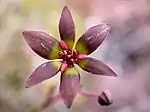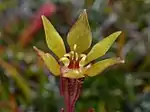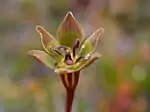Campynema
Campynema is a genus in the family Campynemataceae first described in 1805.[1][3] It contains only one known species (monotypic), Campynema lineare, endemic to the island of Tasmania in Australia.[2][4] Its closest relative is Campynemanthe, endemic to New Caledonia,[5] sole other genus of the family.
| Campynema | |
|---|---|
_(8224180122).jpg.webp) | |
| Campynema lineare Labill. | |
| Scientific classification | |
| Kingdom: | Plantae |
| Clade: | Tracheophytes |
| Clade: | Angiosperms |
| Clade: | Monocots |
| Order: | Liliales |
| Family: | Campynemataceae |
| Genus: | Campynema Labill.[1] |
| Species: | C. lineare |
| Binomial name | |
| Campynema lineare | |
| Synonyms[2] | |
|
Campynema pygmaeum F.Muell. ex Benth. | |
Campynema lineare
C. lineare, also known as the green mountain lily,[6][7] is a small inconspicuous erect herb that grows to 15–30 cm in height. Its leaves consist of a single, curved basal leaf, with smaller leaves ascending up the flower stem.[7] It is most distinguishable by its striking green flower, which blooms in summer.[7] The flower is usually solitary, with 6 green tepals, sometimes with a burgundy tinge and developing brown edges with age,[7] lacking apparent nectaries.[8] The anthers are dorsifixed, styluli are free but thickened and contiguous below. The seeds are numerous and are flattened, sometimes almost discoid, with a spongy outer coat.[8] It is a geophyte,[9] and its leaves are deciduous in winter.
C. lineare is approximately 57 million years old.[10] It is considered to a key member of Tasmania's palaeoendemic flora.[10] A study of the gene sequences of RuBisCO in C. lineare, found that the familyCampynemataceae is the oldest of the order Liliales.[11]
C. lineare was once considered to be part of the family Liliaceae.[7]
- Variation in flower coloration



Distribution
C. lineare can be found in boggy sites in the central, western and central mountains of Tasmania, mostly in the subalpine and alpine regions.[12] It is most commonly found in herbfields, heathlands, cushion plant communities, and lake edges.[13]
Threats and Conservation
C. lineare is not considered under any specific threats due to being situated predominantly in protected areas,[14] however some of the habitats in which it is found are predicted to decline due to climate change.[15] The most likely declines in Australian alpine ecosystems have been shown to be in alpine herbfield and cushion plant communities.[15] Due to its palaeoendemic status, the Tasmanian Parks and Wildlife Service consider C. lineare to be of high conservation significance.[14]
References
- Labillardière 1804, i p. 93.
- Kew World Checklist of Selected Plant Families
- Tropicos, Campynema Labill.
- George, A.S. (ed.) (1987). Flora of Australia 45: 1-521. Australian Government Publishing Service, Canberra.
- Vinnersten, A.; Bremer, K. (2001). "Age and Biogegraphy of Major Clades in Lilliales". American Journal of Botany. 88 (9): 1695–1703. doi:10.2307/3558415. JSTOR 3558415. PMID 21669704.
- Department of Primary Industries, Parks, Water and Environment. "Species Campynema Lineare". Natural Values Atlas Tasmania. Retrieved 24 February 2018.
- Howells, Christine (2012). Tasmania's Natural Flora. Hobart, Tasmania: Australian Plants Society Tasmania Inc., Hobart Group. p. 391. ISBN 9780909830663.
- Kubitzki, K. (1998). The Families and Genera of Vascular Plants, III. Flowering Plants - Monocotyledons Lilianae (except Orchidaceae). Berlin: Springer. pp. 173–174. ISBN 9783662035337.
- Associate Professor Greg Jordan 2018, personal communication, 19 February.
- Jordan, Gregory J.; Harrison, Peter A.; Worth, James R.P.; Williamson, G.J.; Kirkpatrick, J.B. (2016). "Palaeoendemic plants provide evidence for persistence of open, well-watered vegetation since the Cretaceous". Global Ecology and Biogeography. 25 (2): 12–140. doi:10.1111/geb.12389 – via Wiley Online Library.
- Janssen, T; Bremer, Kåre (2015). "The age of major monocot groups inferred from 800+ rbcL sequences". Botanical Journal of the Linnean Society. 146 (4): 385–398. doi:10.1111/j.1095-8339.2004.00345.x.
- Jordan, Greg (2017). "Key to Tasmanian Vascular Plants". University of Tasmania. Retrieved 24 February 2018.
- Smith, Andrew (2009). "Family Index: Campynema lineare". Understorey Network. Retrieved 28 February 2018.
- Tasmanian Parks and Wildlife Service (2014). Melaleuca - Southwest National Park - Site and Rehabilitation Plan. Hobart: Tasmanian Department of Primary Industries, Parks, Water and Environment. p. 15. ISBN 9780992362829.
- Slatyer, Rachel. "Climate change impacts on Australia's alpine ecosystems". Australian National University Press. Retrieved 28 February 2018.
Bibliography
- Labillardière, Jacques Julien Houtou de (1804). Novae Hollandiae Plantarum Specimen (in Latin). Paris: Dominæ Huzard.
 Data related to Campynema at Wikispecies
Data related to Campynema at Wikispecies
